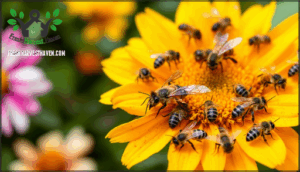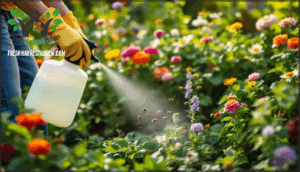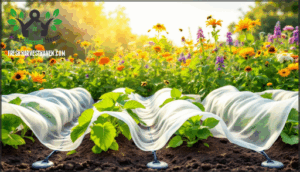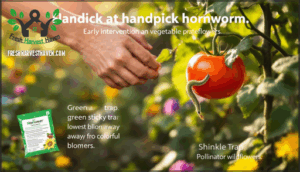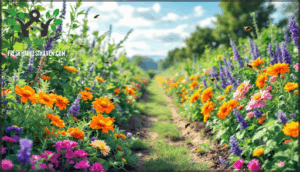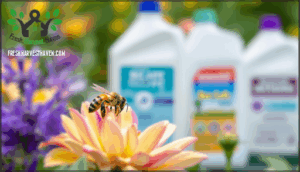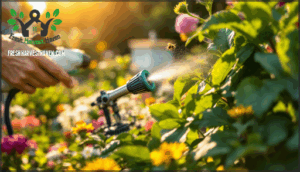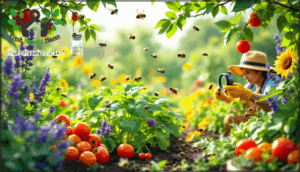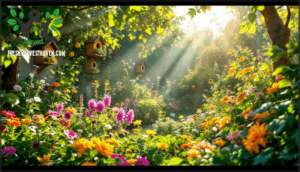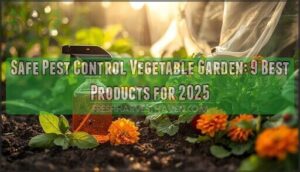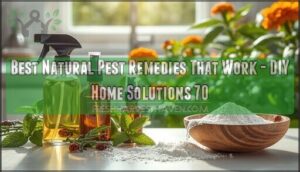This site is supported by our readers. We may earn a commission, at no cost to you, if you purchase through links.
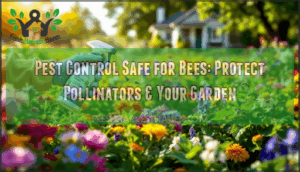 Your garden thrives when pests stay controlled—but conventional pesticides kill more than just the bugs. They devastate bees, the very insects that pollinate your plants and feed your community.
Your garden thrives when pests stay controlled—but conventional pesticides kill more than just the bugs. They devastate bees, the very insects that pollinate your plants and feed your community.
With U.S. honey bee colonies facing projected losses up to 70% in 2025 and roughly a third of global food depending on pollinators, the stakes feel enormous.
Yet protecting bees while managing pests isn’t complicated. You have practical, effective options that work with nature instead of against it. The key is knowing which tools keep both your garden and pollinators healthy.
Table Of Contents
- Key Takeaways
- Why Bee-Safe Pest Control Matters
- Pesticides Harmful to Bees
- Bee-Friendly Pesticide Options
- Non-Chemical Pest Control Methods
- Choosing Pesticides Safe for Bees
- Best Practices for Safe Application
- Integrated Pest Management for Bee Safety
- Supporting Bee Health in Your Garden
- Frequently Asked Questions (FAQs)
- How do you protect bees from pesticides?
- Are pesticides safe for bees?
- How can people manage pests to reduce harm to bees?
- Can you use a pesticide around a bee hive?
- Can pesticide spray kill bees?
- Why do bees need pesticides?
- How do I know if my garden has good pest populations naturally?
- Whats the best timing for applying organic pesticides?
- How long before beneficial insects establish in gardens?
- Should I stop all pest management to protect bees?
- Conclusion
Key Takeaways
- Neonicotinoid pesticides and other systemic chemicals cause up to 100% bee death within 24 hours at certain concentrations, while sublethal effects like impaired orientation and reduced foraging success persist even at lower doses.
- Bee-safe alternatives like sulfur, kaolin clay, diatomaceous earth, insecticidal soaps, and spinosad provide effective pest control without harming pollinators when applied according to label instructions.
- Evening applications after sunset when temperatures drop below 55°F reduce bee exposure by up to 90%, while avoiding the 9 a.m. to 3 p.m. peak foraging window protects pollinators from direct contact with sprayed chemicals.
- Integrated pest management combining non-chemical methods (row covers, hand-picking, beneficial insects, companion planting) with targeted, low-toxicity products reduces overall pesticide use by 30–70% while maintaining yields and protecting bee populations.
Why Bee-Safe Pest Control Matters
Bees aren’t just buzzing through your garden for fun—they’re keeping our food system alive. When their numbers drop, so does our ability to grow the fruits, vegetables, and nuts we depend on.
Let’s look at why protecting these pollinators from harmful pest control practices matters for everyone.
The Importance of Bees in Pollination
Bees are the unsung heroes of crop pollination, visiting over 80% of all flowering plants and supporting approximately $20 billion in U.S. agriculture annually. Their work goes far beyond honey production—bees improve ecosystem biodiversity, boost yield enhancement in fruits and vegetables, and secure our food security.
Bees pollinate over 80% of flowering plants and generate $20 billion annually in U.S. agriculture, making their protection essential to food security and ecosystem health
Without these pollinators, you’d see grocery shelves looking emptier and prices climbing higher. Their economic value touches everything from your morning coffee to the almonds in your pantry, making pollinator health essential for bee-friendly gardening and the role of bees in ecosystems. These efforts have an economic value of billions in the United States.
Consequences of Bee Decline
When pollinators decline, the ripple effects touch everyone. U.S. honey bee colonies face projected losses of up to 70% in 2025, threatening ecosystem disruption and biodiversity loss across natural habitats.
This ecological disruption limits food security—approximately 35% of global food production depends on pollinators like bees. Economic impacts reach $20 billion annually in U.S. agriculture alone, while pesticide exposure and environmental threats continue weakening pollinator health, ultimately affecting human health through reduced access to nutrient-rich crops.
The decline greatly impacts US agriculture, potentially leading to lower crop yields and higher grocery prices.
How Traditional Pest Control Harms Bees
Traditional pesticides pose serious dangers to bees through multiple pathways. Pesticide exposure leads to immediate mortality—studies show neonicotinoid mixtures caused 100% bee death within 24 hours at certain concentrations.
Beyond lethal effects, harmful pesticides for bees disrupt orientation and learning, reducing foraging success. Behavioral disruption from pesticide toxicity to bees impairs their communication dances.
Reproductive effects include reduced queen vitality and 19% drops in pollen collection. CCD impact connects directly to systemic insecticides, while habitat loss accelerates as pesticides contaminate forage areas, decreasing wild bee populations by 43% in high-use regions.
Pesticides Harmful to Bees
Not all pest control products are safe for the bees working hard in your garden. Some pesticides can kill bees on contact or harm them in ways that aren’t immediately obvious.
Let’s look at which products pose the biggest risks and how you can spot them before they become a problem.
Common Pesticides to Avoid
When you reach for a spray bottle, you’re making a choice that matters. Several chemical pesticides pose severe risks to bees, and knowing which to avoid is essential.
Organophosphate dangers include phosmet and profenofos, which disrupt bee neurological function. Pyrethroid toxicity from prallethrin and resmethrin causes rapid knockdown effects. Neonicotinoids like imidacloprid and thiamethoxam remain hazardous for days after application. Miticide risks extend to pyridaben and rotenone, killing bees within hours.
Label interpretation helps identify "Bee Hazard" symbols indicating harmful pesticides for bees, guiding you toward neonicotinoid alternatives with lower pesticide toxicity to bees.
Effects of Neonicotinoids and Imidacloprid
Among garden dangers, neonicotinoids and imidacloprid rank as some of the most damaging to bee health and survival. These substances create widespread harm through multiple pathways:
- Population declines: Exposure to neonicotinoid-treated crops caused a threefold increase in wild bee extinction rates, with species occupancy dropping over 40% in high-use farming areas.
- Sublethal effects: Field-relevant doses disrupt direction and learning, cutting foraging efficiency by up to 50% while impairing memory and hive care.
- Immune suppression: Imidacloprid weakens defenses against gut pathogens like Nosema, raising mortality rates over 20% in exposed colonies.
- Environmental persistence: Residues linger in soil, pollen, and nectar for years, creating chronic pesticide exposure for ground-nesting and foraging bees across generations.
- Species impact: Solitary, bumble, and honey bees all suffer reproductive decline and reduced survival, threatening pollination services you depend on.
Understanding these effects of pesticides on bees helps you protect the pollinators working in your garden.
How to Identify Toxic Products
Before you buy any pesticide, you should read the label carefully to spot bee hazards. Since 2022, the EPA requires a bee advisory icon—a bee inside a red diamond—on products risky to pollinators. Check the "Environmental Hazards" section for toxicity statements and look for high-risk active ingredients like carbaryl, imidacloprid, or deltamethrin. Risk statements often ban application to blooming plants when bees forage, and toxicity metrics (LD50 values under 2 µg/bee) mark Group I products as highly toxic. These label warnings and application restrictions help you avoid harming bees while managing pests safely.
| What to Check | Red Flags for Bee Safety |
|---|---|
| Label Warnings | Bee icon in red diamond; "highly toxic to bees" statement |
| Active Ingredients | Organophosphates, carbamates, pyrethroids, neonicotinoids |
| Toxicity Groups | Group I (LD50 < 2 µg/bee) or Group II warnings present |
| Risk Statements | "don’t apply to blooming crops"; 8+ hour reentry intervals |
Bee-Friendly Pesticide Options
You don’t have to choose between protecting your plants and protecting bees. Several pesticide options work well against pests while posing little to no risk to pollinators when used correctly.
Let’s look at the safest choices and how to apply them without putting bees in harm’s way.
Organic Pesticides Safe for Bees
You don’t have to sacrifice bees for pest control. Organic pesticides like sesame oil and potassium fatty acid soaps target soft-bodied pests without harming pollinators.
Products with OMRI certification meet strict toxicity levels—many show LD50 values over 100 µg/bee, which means they’re practically non-toxic.
Field evidence confirms these bee-friendly pesticides work without disrupting colony health when you follow proper application methods and regulatory standards.
Mineral-based and Natural Alternatives
Kaolin clay and diatomaceous earth act like invisible shields—covering plants without entering bees’ systems. Studies confirm kaolin clay reduces pest damage by 56–70% with zero bee mortality, while diatomaceous earth kills aphids through physical action, not poison.
Horticultural oils and mineral-based pesticides from plant sources like potassium bicarbonate offer 65% pest control with high bee-friendly ratings. Combined formulations mixing natural ingredients with minerals boost effectiveness beyond 85% while keeping pollinators safe.
Application Timing to Minimize Bee Risk
When you spray pesticides matters as much as what you spray. Bees forage when temperatures climb above 55°F, so evening applications after sunset keep them safe in their hives. Here’s your timing strategy:
- Spray after sunset – Most bees return by dusk; evening applications reduce direct contact by up to 100% for fast-degrading products
- Check residual toxicity – Pesticides with RT25 values under 8 hours dry harmlessly overnight before morning foraging begins
- Watch temperature thresholds – Apply when it’s cool enough to prevent bees from extending foraging hours unexpectedly
- Reduce drift in calm conditions – Still evenings mean less pesticide drift toward nearby apiaries and forage areas
- Communicate with local beekeepers – Early notification improves survival rates by 30–40% in shared agricultural areas
Reading your pesticide label for bee protection information and environmental hazard statements makes certain you’re choosing products that work with your timing strategy, not against it.
Non-Chemical Pest Control Methods
You don’t always need chemicals to manage garden pests effectively. There are plenty of straightforward methods that protect your plants while keeping bees safe and thriving.
Let’s explore some practical approaches that work.
Physical Barriers and Row Covers
Think of row covers as protective shields for your young plants. These lightweight fabrics act as physical barriers, keeping pest insects away without any chemicals. They’re especially effective during early growth stages, sometimes increasing yields six times over compared to untreated plots. The catch? Complete enclosure blocks pollinator access. Strategic removal during flowering—lifting covers for 1.5 to 4 hours each morning—restores pollination while maintaining pest protection. Cover materials like polypropylene and mesh also alter microclimates, reducing wind stress and moderately increasing humidity. Plan ahead for weed management beneath covers, and remove them when your plants need bee visits most.
| Aspect | Benefit | Consideration |
|---|---|---|
| Pest Control | 3.6× higher marketable yield | Requires secure edge sealing |
| Pollination | Morning removal restores bee access | Must time removal during flowering |
| Microclimate | 63% wind reduction, improved growth | Increased humidity risks fungal issues |
| Weed Management | Reduces pest pressure early-season | Requires pre-planned cultivation |
| Bee-Friendly Use | Zero chemical pesticides needed | Strategic timing essential for natural pollination |
Hand Picking and Bug Traps
When row covers come off, two reliable methods take over: handpicking and bug traps. Handpicking eliminates up to 90% of foliage-feeding pests like squash bugs and hornworms during early infestations, especially when you scout regularly—this approach cuts chemical needs by 40–60%.
Sticky traps capture flying pests like whiteflies and aphids, while shingle traps target ground-dwellers. The key to protecting bees? Position traps below bloom level, away from flowering plants, and use green or white colors instead of yellow. Green traps capture fewer bees than yellow ones.
These nonchemical options integrate seamlessly into your pest management strategy, reducing overall pesticide reliance considerably.
Companion Planting and Beneficial Insects
When handpicking and traps remove early pests, companion planting takes pest control further by building living ecosystems. Planting nectar-rich flowers alongside crops attracts beneficial insects—ladybugs, lacewings, and parasitic wasps—that hunt pest populations naturally. This floral diversity increases native bee visitation by 42% while supporting predator habitats that suppress pests by up to 90%. IPPM synergy combines these flowering companions with predatory insects, reducing synthetic pesticide use over 40% across farms. Strategic soil health through diverse plantings strengthens plant immunity and sustains biological controls year-round, protecting both your harvest and pollination rates.
- Companion flowers attract predators that eliminate soft-bodied pests without chemicals
- Floral diversity increases bee visits 42% while supporting natural pest control
- IPPM synergy reduces pesticide use over 40% by combining multiple strategies
- Diverse plants strengthen soil health, boosting plant immunity and long-term pest suppression
Choosing Pesticides Safe for Bees
In treating pest problems, not all pesticides are created equal. Some products can seriously harm or even kill bees, while others are designed to target pests with minimal risk to pollinators.
The key is knowing which ingredients to look for and which ones to avoid. Here’s what you need to know to make the right choice for your garden and the bees that depend on it.
Selecting Low-toxicity Products
When selecting pesticides, focus on products with LD₅₀ values above 100 µg/bee—the EPA’s threshold for practically non-toxic compounds. Check labels for bee-friendly pesticide certifications and avoid anything containing systemic neonicotinoids, which persist in pollen and nectar. Look for organic labels confirming low-toxicity ratings through UC IPM’s Bee Precaution System.
Night application further reduces bee exposure. Products using mineral oils, insecticidal soaps, or natural ingredients like sesame oil offer effective pest control without harming pollinators.
Avoiding High-risk Ingredients
Now comes the hard part: knowing what to avoid. Neonicotinoids like imidacloprid, clothianidin, and thiamethoxam cause over 90% of pesticide-related bee deaths in Europe. Organophosphates such as diazinon and chlorpyrifos deliver lethal doses within hours of contact. Pyrethroids including permethrin remain toxic on plant surfaces for days. Carbamates like carbaryl decimate foraging populations within 72 hours. Even synthetic additives and surfactants in formulations increase toxicity by 50%.
Read every label carefully. If you see these ingredients, put the product back on the shelf.
Best Practices for Safe Application
Timing and technique matter just as much as choosing the right product. The way you apply a pesticide—and when you apply it—can be the difference between protecting your garden and harming the bees you want to support.
Here’s how to get it right.
Applying Pesticides When Bees Are Not Active
Timing is everything when you spray. Bees forage when temperatures exceed 52°F and daylight peaks—usually 9 a.m. to 3 p.m. Evening applications after sundown reduce bee exposure by up to 90%. Night spraying also minimizes drift over 70%, protecting nearby blooms. Consider species variation: native bees start earlier than honeybees, while bumblebees adapt to cooler conditions. Regulatory guidelines recommend nighttime or early-morning applications during bloom stages. Calm evening conditions with temperatures below 55°F align with low bee flight activity, making these windows ideal for pesticide application safety.
- Apply pesticides after sundown when foraging stops and temperatures drop below 55°F
- Avoid the 9 a.m. to 3 p.m. window when bee activity peaks most intensely
- Time applications before or after flowering stages to reduce pollinator contact risk
- Use calm evening conditions to minimize drift beyond treated areas
Targeted Application Techniques
Narrowing your spray focus cuts waste and shields bees. Precision spraying systems using sensors reduce drift by 80–90% while cutting pesticide use by up to 60%. Spot treatments with AI identify problem zones, letting you treat only what needs it—sometimes reducing overall application by 85%. GPS-guided sprayers limit treatment to targeted areas, leaving nearby flowering plants and bee forage untouched. Pair these methods with hive communication systems that alert beekeepers before application, creating a protective barrier around pollinator activity.
| Technique | Drift Reduction |
|---|---|
| Sensor-controlled sprayers | 80–90% |
| Spot treatment with AI | 85% less pesticide |
| GPS-guided application | Targeted zones only |
| Drift-control adjuvants | 60% fewer fine droplets |
| Lower boom height | 70%+ reduction |
Weather and Environmental Considerations
When conditions shift, your pesticide strategy must shift with it. Temperature, humidity, wind, and rainfall dramatically reshape how chemicals behave in your garden—and how vulnerable bees become to exposure.
Temperature extremes hit hardest. Cold snaps at 21°C heighten pesticide toxicity, reducing bee activity by up to 35%, while warm winters deplete the fat reserves bees need for detoxification, cutting lifespan by 70%. Humidity extends pesticide persistence on plants by 60%, stretching exposure windows. Wind speeds above 15 km/h can increase contamination in nearby bee habitats by 300%, with drift traveling up to 32 meters. Rainfall within 48 hours of application doubles residue translocation to non-target plants.
Your safest application window? Calm, dry mornings when bees aren’t foraging and conditions won’t heighten harm.
- Avoid spraying when temperatures drop below 25°C or exceed 30°C
- Skip applications before rain within 48 hours
- Choose still mornings with humidity below 70%
- Maintain 10–20 meter buffer zones from hives
- Monitor forecasts to time applications when environmental risk is lowest
Integrated Pest Management for Bee Safety
Integrated Pest Management (IPM) is a practical approach that combines different strategies to keep pests under control while protecting bees and your garden. Instead of relying on one solution, you’ll use a mix of chemical and non-chemical methods designed for your specific needs.
This balanced strategy reduces your overall pesticide use but also makes your garden more resilient to pest problems over time.
Principles of Integrated Pest Management (IPM)
Integrated pest management takes a straightforward approach: use the most economical methods with the least harm to people, property, and the environment. Rather than spraying everything when pests appear, IPM works through four key stages—prevention, monitoring, decision-making based on thresholds, and intervention using the least-risky methods.
You monitor pest populations regularly and only act when they reach levels that actually damage your plants. This selective controls approach reduces pesticide use by 25–50% while maintaining yields.
By combining biological, cultural, mechanical, and chemical strategies instead of relying solely on chemicals, you protect bees while saving money. The continuous improvement built into IPM means you evaluate what works and adjust your approach, making your pest control methods smarter over time.
Combining Chemical and Non-chemical Strategies
The best approach isn’t either-or—it’s both. Layer non-chemical methods first, then add reduced-risk chemicals only when needed. For example, row covers stop pests before they arrive, then you introduce beneficial insects. If problems persist, use bee-safe products like sulfur or spinosad. This combination cuts pesticide use by 40% while maintaining yields.
Research shows pairing microbial biopesticides with minimal insecticides reduces chemical applications 30% on average. Targeted application equipment further limits drift by 80%, protecting foragers.
Monitor pest populations carefully; treat only when thresholds warrant action. This operational protocol delivers bee-safe outcomes without sacrificing harvest quality.
Reducing Overall Pesticide Use
Reducing pesticide use doesn’t mean sacrificing results. Global trends show farms cutting applications by 30–70% through integrated pest management while maintaining yields.
Here’s what works: Start with non-chemical methods like row covers and beneficial insects. Add targeted, low-toxicity products only when pest populations exceed treatment thresholds. Precision sprayers cut chemical drift by 80%, protecting foragers.
Policy incentives and tech alternatives—from AI pest detection to pheromone traps—make this shift economical. You’re not just protecting bees; you’re lowering costs and building resilience.
Supporting Bee Health in Your Garden
Beyond choosing the right pesticides, your garden itself is a powerful tool for keeping bees safe and thriving. When you create a healthy environment on your property, you’re doing more than just protecting individual insects—you’re building a space where bees can find food, water, and shelter without encountering harmful chemicals.
Here’s what you can do to support bee health in your garden.
Planting Bee-friendly Flowers
Flowers are your secret weapon in supporting bee populations. Over 90% of plants reviewed for pollinator benefits showed measurable advantages for bees, so your garden choices matter.
Plant bee-friendly species like lavender, sunflowers, coneflowers, and asters to provide consistent nectar and pollen. Mix native wildflowers with selected non-native ornamentals to increase floral diversity and support varied bee species.
Stagger your blooms across seasons—early crocus, mid-summer cosmos, late-season rosemary—so bees find food from spring through fall. In urban areas, this seasonal forage becomes even more critical since temperature stress already reduces bee populations.
Dense, diverse flowering plants create a pollinator habitat that sustains colonies and wild bee communities through the year.
Providing Clean Water and Safe Forage
Your flower garden feeds bees, but they also need water and pesticide-free food sources to thrive. Bees consume up to 1 liter daily on hot days, making water source proximity critical. Place shallow drinkers with floating cork or pebbles near your hives to reduce drowning risk and energy expenditure.
Forage diversity is equally important. Ensure your pollinator habitat includes blooming plants across seasons, and avoid pesticide applications near flowering areas. Contamination risk reduction occurs when you provide elevated bee drinkers away from agricultural runoff and maintain pesticide-free forage zones.
Safe forage and clean water working together maintain colony health and boost your garden’s productivity.
Community Engagement and Advocacy
Your individual efforts compound when you connect with others. Community education programs like Bee City USA reach hundreds of thousands annually, while citizen science initiatives across 15 states track pollinator health. Join local advocacy networks, communicate with neighbors about bee-safe practices, and support policies that restrict harmful neonicotinoids. Partner with schools and businesses to expand pesticide-free zones. Together, you’re building resilience for both bees and your community’s food security.
- Participate in local Bee City or Bee Campus programs for education and resources
- Contribute to citizen science projects monitoring pollinator activity in your region
- Advocate for integrated pest management policies in your municipality
- Share bee-safe practices with neighbors and local gardeners
- Support corporate and community partnerships funding pollinator habitat conversion
Frequently Asked Questions (FAQs)
How do you protect bees from pesticides?
Picture bees returning to their hive after foraging, carrying contaminated pollen. Protecting them starts with strategic hive placement away from treated areas, monitoring forage for pesticide residues, and timing management to avoid peak foraging hours.
Provide clean water sources, reduce exposure through bee-friendly pesticide alternatives, and embrace integrated pest management to safeguard their health.
Are pesticides safe for bees?
Not all pesticides are safe for bees. Many conventional pesticides, especially neonicotinoids and imidacloprid, cause significant pesticide exposure and sublethal effects that impair orientation and reduce worker bee lifespan by up to 30%. Systemic pesticides pose particular toxicity risks.
However, bee-friendly alternatives like sulfur, Serenade, kaolin clay, and spinosad allow you to manage pests while protecting pollinators through proper risk assessment and application timing.
How can people manage pests to reduce harm to bees?
Manage pests through integrated pest management: combine safe pesticide alternatives like sulfur and neem oil with non-chemical methods including row covers, hand-picking, and companion planting.
Time applications when bees aren’t foraging, improve forage with pesticide-free plants, and build community awareness about pollinator protection.
Can you use a pesticide around a bee hive?
Yes, you can use pesticides around a bee hive, but it requires careful planning. Choose bee-safe options like sulfur or Serenade. Time applications for early morning or evening when bees aren’t foraging.
Maintain hive proximity distance, use drift mitigation techniques, and monitor colony health closely. Consider colony relocation if pesticide use is extensive.
Can pesticide spray kill bees?
Yes, pesticide spray can kill bees. Spray toxicity varies by pesticide type and exposure routes. Some sprays cause immediate death, while others create sublethal effects like impaired orientation or reduced lifespan. Spray drift exposes different bee species beyond your target area.
Always check labels for bee-safe ratings and avoid application during foraging hours.
Why do bees need pesticides?
Bees don’t need pesticides—you do. Bees are pollinators, not pests. However, protecting your crops from actual pests sometimes requires pesticide use.
The challenge is choosing products that control harmful insects while keeping bees safe during pollination.
How do I know if my garden has good pest populations naturally?
Look for beneficial insect signs like ladybugs and lacewings actively hunting pests. When you observe predator activity and minimal plant damage, your garden’s natural pest balance is working.
Healthy ecosystem indicators—few pest populations needing intervention—suggest integrated pest management through natural methods is already underway.
Whats the best timing for applying organic pesticides?
Timing matters more than you’d think. Apply organic pesticides in early evening or late afternoon when bee activity drops considerably. Avoid bloom times entirely, and check weather conditions—rain within 24 hours reduces product persistence and effectiveness.
Always read labels for bee-safe application windows and product persistence data.
How long before beneficial insects establish in gardens?
Beneficial insects generally establish within 2-4 weeks once you introduce them or create habitat conditions. Population dynamics depend heavily on environmental factors—adequate insectary plants, shelter, and water speed establishment.
For monitoring success, watch for increased predation activity.
With integrated pest management strategies combining natural methods and organic pest control, you’ll build sustainable populations that support bee-friendly gardening long-term.
Should I stop all pest management to protect bees?
No—stopping all pest management isn’t realistic or necessary for bee safety. Instead, adopt sustainable pest control that balances crop protection with pollinator health.
Use organic alternatives, beneficial insects, and physical barriers first. Reserve pesticides for serious infestations, choosing bee-friendly options and applying them when bees aren’t foraging.
This integrated approach protects both your garden and bee populations.
Conclusion
Your garden’s future rests on a single truth: the insects you kill today determine what grows tomorrow. When you choose pest control safe for bees, you’re not just protecting pollinators—you’re securing your own harvest.
By combining targeted application, natural alternatives, and integrated pest management, you create a garden where both pests and bees find balance. Start small, stay consistent, and watch your garden flourish.
- https://beyondpesticides.org/dailynewsblog/2024/05/study-finds-chemical-industrys-bee-safe-claim-for-its-pesticides-to-be-false/
- https://www.nature.com/articles/s41893-024-01413-8
- https://pmc.ncbi.nlm.nih.gov/articles/PMC6359572/
- https://bestbees.com/pesticides-and-pollinators/
- https://www.epa.gov/pollinator-protection/policy-mitigating-acute-risk-bees-pesticide-products

